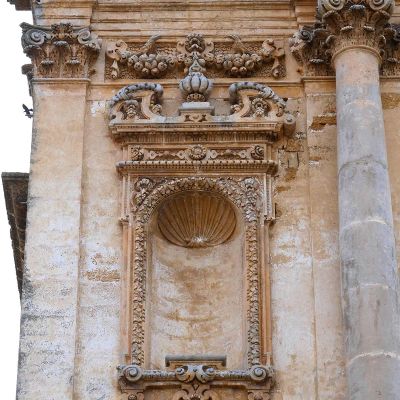The Church of Saint Anne
The church of Saint Anne was built between 1683 and 1699, the project of the Mesagnese canon and architect Francesco Capodieci, as an offering on behalf of Vittoria Capano, the widow of Prince Niccolò De Angelis, to Saint Anne in order to cure her son Carmine. The facade in Leccese stone, built by the masters of Salentino Baroque, Pietro Elmo and Giuseppe Cino, is one of the finest examples of the Baroque in Puglia. Vertically tripartite, it displays a double order of columns and half pilasters, amongst which four recesses open that would have perhaps hosted statues of the four evangelists, it is surmounted by a high pediment with medallion on which the year of completion is displayed; 1699.
The richly decorated portal displays a curvilinear tympanum and hosts a medallion supported by two cherubs, probably for the crest of the De Angelis family or the image of Saint Anne. The Church of Saint Anne was the last of Capodieci’s projects who, in 1683, was already 78 years old. He died in 1688 before the work on the church was finished.
The construction of the church and the piazza opposite gave a new aspect to the existing urban structures inside the city walls. To create space for the building a fifteenth century tract of wall was torn down and the houses of an entire block were purchased by the De Angelis family and demolished in order to create the piazza’s spectacular visual impact. The Princess Capano wanted a church that could compete in terms of beauty with the Collegiata (this project was also built by Capodieci years earlier) and probably for this reason the stone carvings on the facade were entrusted to two master sculptors of the calibre of Petro Elmo and Giuseppe Cino, who followed to the letter the plans of Francesco Capodieci.
The result is a perfect union of sculptural and decorative elements which are the fruit of the creativity and experience of the Mesagnese architect. The Church of Saint Anne was completed in 1699 and opened for worship a few years later. It was Prince Carmine De Angelis that finished the work desired by his mother. He was also the person who commissioned the altarpieces. During the same period, he restored the baronial palazzo and had the attic space painted of the great room by the Mesagnese painter Luca Pacciolla.
The interior of the church is straightforward with one nave and a vaulted roof. There are two lateral altars and two doors to access the wooden women’s galleries from the 17th century. On the sides of the high altar there are two doors; one to access the sacristy and the other connects with the baronial palazzo. The altar is made of stone, clad in fake marble stucco. The three seventeenth century canvas paintings placed on the respective altars are of uncertain attribution. On the high altar there is a painting of the Nativity, with the usual figures of the shepherds, Mary and Joseph and Saint Anne with Saint Joachim. On the altar dedicated to the Blessed Crucified Christ there is a painting of the Crucifixion with Saint Francis and Saint Catherine of Siena and on the altar of the chapel of Saint Oronzo there is copy of the Deposizione by Paolo Caliari (known as il Veronese), possibly painted by Andrea Cunavi or Giacomo da San Vito.








